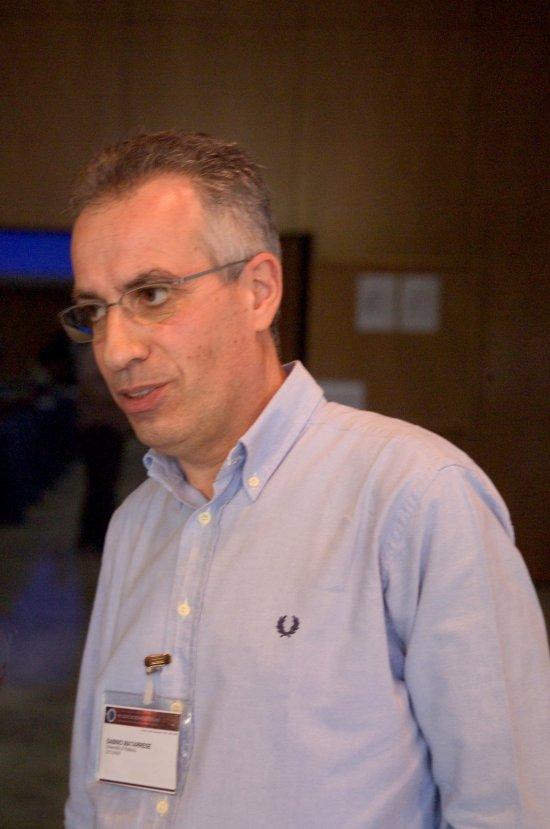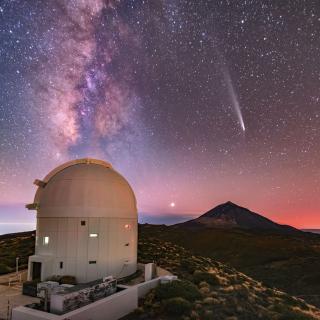Max Planck had already said it a century ago. We cannot speak of time before everything began – time zero, if there could be such a thing – when, according to the Theory of Everything, the four fundamental forces of Nature – gravity, electromagnetism, and the strong and weak subatomic forces – were unified into a single force. To describe the Universe before the first 10-43 seconds – the so-called Planck time, named after the German physicist – is impossible in terms of present-day physics. But a fraction of a second later, the Universe expanded and cooled, and the gravitational force became separated from the other three interactions. It was a crucial moment: an abrupt change occurred in the initial conditions and, as a consequence, an explosion happened that liberated an immense amount of energy that accelerated the expansion. During this process, which the American cosmologist Alan Guth dubbed “inflation” – the first stage succeeding the “Big Bang” that supposedly gave birth the Universe – all the cosmic matter and energy was created. Reconstructing these first moments is one of the scientific obsessions of Sabino Matarrese, a theoretical physicist at the University of Padua (Italy). This researcher today inaugurated the XIX Canary Islands Winter School at the Congress Centre at Puerto de la Cruz (Tenerife), this year’s topic being “The Inflationary Universe: From Quantum Fluctuations to the Present Universe”.
Early cultures always tried to explain the large-scale Universe as a whole, together with its origin and evolution. Such interpretations were quite respectable in their day, quaint though some of them might seem to us today from our modern perspective. Current cosmological models are possible representations of the Universe generally expressed through mathematical equations. The Big Bang theory, now the one most widely accepted by the scientific community, is one of these. Indeed, astronomers refer to it as the Standard Model of the origin of the Universe, although in order to tie a few loose ends, a new concept, inflation – the extraordinary growth registered by the Universe for a fraction of a second after the initial great explosion – has been added to the original theory. But what was the Universe doing before it started to expand? ‘If this question refers to the acceleration of the expansion during inflation (in the early Universe),’ says Matarrese, ‘then the correct answer would be that there was no such thing as an epoch prior to inflation. Cosmology, the reconstruction of events, can only go as far back at the “Planck time” (10-43 seconds), the smallest unit of time that has physical meaning.
‘According to the present view of the history of the Universe, based on the inflationary paradigm, there was nothing,’ cautions Matarrese, ‘like a real beginning of time. The (global) Universe has always been there, just like in the old-fashioned stationary Universe. On the other hand,’ he adds, ‘observations tell us that we happen to live in a local region of the above global Universe, which, after having undergone inflation (i.e., exponential growth on all scales) has been reheated, so that all the matter and radiation that we know has been “regenerated”. In such a local patch of the Universe for most practical purposes we can continue to say there was a beginning of time, a Big Bang.
THE INFLATIONARY UNIVERSE
The Big Bang theory maintains that the Universe began some 13,000 million years ago when a single infinitely dense and infinitely hot point of matter called a “singularity” exploded, releasing an immense amount of energy. At that instant in time, close to the origin, everything was homogeneous and particles were indistinguishable from one another. The four forces of Nature were also equivalent, and matter and radiation were in equilibrium. At such high temperatures, the number of disintegration processes between each particle and its antiparticle was identical to the number of creation processes.
As the Universe expanded, the matter cooled gradually, undergoing phase transitions – abrupt changes in its properties as it reached a critical value, as happens with a physical change of state. After the rapid exponential growth from inflation lasting a mere trillionth of a trillionth of a second, produced by “vacuum energy” (background energy existing in space itself even in the absence of matter), the expansion of the Universe recovered its normal pace.
The theory of inflation was proposed to provide an answer to certain open questions concerning the Big Bang, such as how to explain the large-scale uniformity of the observed Universe and render it compatible with the “observable horizon” (the limiting distance from which a luminous signal from the beginning of the Universe can reach the observer). If the inflationary model is correct, the Universe we see is but a tiny fraction of the Universe in its entirety.
Although not all scientists subscribe to the inflation theory, which its critics consider to be risky and still lacking in firm evidence to back it up, Matarrese, in contrast, is quite clear about his support for the theory: ‘The theory of the inflationary Universe is extremely solid and its competitors either fail completely in predicting what we observe (this is the case of the theory based on cosmic strings) or effectively turn out to be very similar to inflation. The best argument in favour of inflation is based on the perturbations that we observe as temperature anisotropies in the cosmic microwave background (CMB).’ It is precisely to speak about the relation between these observations and the inflationary Universe that this researcher is participating in the Canary Islands Winter School of Astrophysics, this year’s theme being “The Inflationary Universe: From Quantum Fluctuations to the Present Universe”.
The radiation we receive from the cosmic microwave background comes neither from stars nor galaxies, but from the dark background that we see, hence its name. It is light emitted 300,000 years after the Big Bang. We are therefore dealing with fossil radiation from the earliest epoch of the Universe, which has a temperature of only three degrees above absolute zero, and which reaches us today in a very diluted form, mainly as short radio waves (microwaves). Although it is apparently homogeneous, this radiation is not equally distributed in all directions, as was demonstrated more than a decade ago by the COBE satellite and the Tenerife Experiment at Teide Observatory. In fact, the CMB shows small variations in different directions (called anisotropies or inhomogeneities in scientific parlance). The study of this radiation can help us understand how the primitive Universe was transformed into the one we see today and to see why the present distribution of galaxies, in the form of clusters and superclusters, voids and other structures, is the result of infinitesimally small variations in the radiation from matter at a very early epoch of the Universe.
THE “INFLATON” PARTICLE
‘Whatever happened (if anything! - see above) prior to inflation,’ explains Matarrese, ‘it was completely cancelled out by the domination of the vacuum energy during inflation. This is called the cosmic “no-hair” theorem [an effect that implies the total loss of information from a body undergoing collapse as seen from the region surrounding the body], which tells us that if there is something behaving like vacuum energy, all other cosmic ingredients are eventually washed out. Inflation will, however, create the seeds of cosmic structure formation and of CMB anisotropies, as well as gravitational waves, from quantum oscillations of the vacuum state.’ He adds: ‘Towards its end (which happens more or less around 10-33 seconds after what we used to call the “Big Bang”) thescalar field [a form that the matter in the early Universe might have adopted that contained a great amount of energy, which we cannot see, as with the electromagnetic field of the Earth] that caused inflation (the so-called “inflaton”) gives rise to the “reheating” of the Universe, during which matter and radiation were created. So, at the end of inflation one has a local Universe that seems very homogeneous and isotropic, with an almost flat geometry, and endowed with very tiny irregularities corresponding to the seeds for later cosmic structure formation, etc.’
According to this inflationary model, the early Universe was very simple, denominated in fact as a unique particle that gives rise to inflation according to the theory, and with which the only significant variations result from weak quantum interactions with it. In a universe in normal expansion, the density of matter falls, something that does not happen with the scalar field and its energy. This means that space is stretched more quickly and during a greater length of time, eventually disintegrating and producing normal particles. The scalar field too loses energy with time, also disintegrating and producing normal particles. It is then that a hot universe appears as contemplated according to the classical Big Bang theory.
‘CMB experiments,’ says Matarrese, ‘may tell us the energy scale of inflation, which is very likely the GUT [grand unified theory] scale. This scale can be probed by the polarization of the CMB [the orientation of oscillation of the radiation resulting from its interaction with electrons] when looking for primordial gravitational waves.’ [These waves were supposedly generated during inflation, just as predicted by the Einstein’s theory of General Relativity.] ‘In many aspects,’ emphasizes Matarrese, ‘this is the greatest challenge to future CMB experiments and will provide a unique piece of evidence for the GUT scale.
THE PLANCK MISSION
With its avowed aim to approach the “Planck era”, the earliest period of time in the history of the Universe, this mission could not have been called anything else. The Planck mission, which will be launched by the European Space Agency on 31 July 2008, and in which the IAC is participating with an instrument, is designed to study the origin and evolution of cosmic microwave background radiation. It will be the third space mission in this field after the COBE and WMAP satellites, but it will be the most advanced.
As a member of the Planck team, Matarrese believes that this mission will offer a unique opportunity to obtain answers of fundamental importance to cosmology. ‘First of all’ he notes, ‘it will provide us with a high-precision determination of most cosmological parameters as well as some of the properties of elementary particles. Second, it will give us important information on the so-called secondary anisotropies.’ [These are variations in CMB radiation generated by the interaction of radiation with matter in the time interval from recombination, when the first stable hydrogen and helium atoms were formed, until the present.] ‘This in turn will give us a quantitative understanding of the large-scale structure of the Universe. Personally,’ Matarrese comments, ‘I would add to this list my specific interest in a possible knowledge of what is called the “non-Gaussianity” of the primordial perturbations, i.e. deviations from the simplest possible statistics of the primordial seeds. The possible presence of primordial non-Gaussianity would have tremendous importance for our knowledge of the nature of the inflaton and of the perturbation-generating process.’
PRESS ROOM: http://www.iac.es/winschool2007/pages/press-room.php



